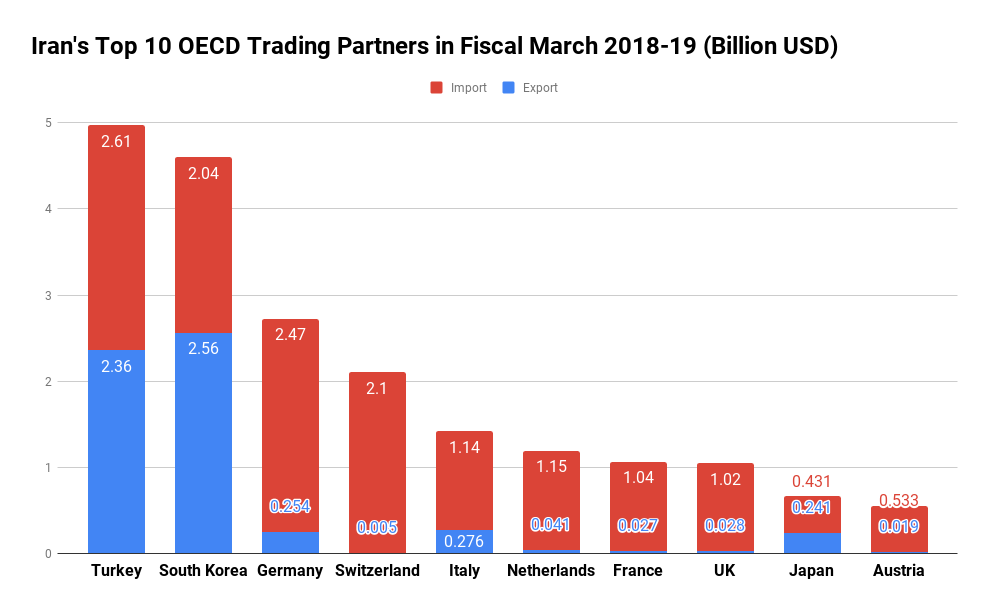Latest data released by the Islamic Republic of Iran Customs Administration show Iran’s exports totaled 13.19 million tons worth $6.24 billion during the year to March 20, indicating a 51.09% and 40.91% decrease in tonnage and value respectively year-on-year.
Imports stood at 13.8 million tons worth $16.89 billion, down 16.72% and 23.29% in tonnage and value respectively YOY.
As a result, Iran recorded a non-oil trade deficit of $10.64 billion with OECD states, Financial Tribune reported.
Founded in 1961, OECD is an intergovernmental economic organization with 36 member countries focused on stimulating economic progress and world trade. It is a forum of countries describing themselves as committed to democracy and the market economy, providing a platform to compare policy experiences, seek answers to common problems, identify good practices and coordinate domestic and international policies of its members.
Main Commodities, Trading Partners
Iran mainly exported gas condensates, liquefied natural gas, non-alloy zinc, urea, floorings, non-alloy aluminum and methanol to the OECD states.
In exchange, major commodities imported into Iran from OECD nations included field corn, soybean, oilcake, auto parts, pharmaceuticals, barley and sunflower oil.
In terms of total trade value, Turkey topped the list among OECD countries with Iran trade standing at 8.15 million tons worth $4.98 billion, indicating a 49.54% and 30.61% decrease in tonnage and value respectively YOY.
Exports to Turkey amounted to 6.76 million tons worth $2.36 billion to register a 52.72% and 40.22% decline in tonnage and value respectively YOY.
Turkey was Iran’s second export destination among the countries under review and sixth in the world.
In return, Turkey exported 1.39 million tons of commodities worth $2.61 billion to Iran, down by 24.96% and 18.79% in tonnage and value respectively YOY.
Turkey was the top exporter of goods to Iran among OECD states and third in the world after China and the UAE.
Major Iranian commodities exported to Turkey were liquefied natural gas, non-alloy zinc, aluminum, urea and bitumen.

In return, Turkey mainly exported cooking bananas, tobacco and fibers to Iran.
South Korea was Iran’s second biggest trading partner among OECD nations during the period under review, as two-way commercial exchanges stood at 5.64 million tons worth $4.61 billion to register a 51.05% and 43.03% fall in tonnage and value respectively YOY.
Iran exported 4.91 million tons of goods worth $2.56 billion to South Korea, down by 51.07% and 41.46% in tonnage and value respectively YOY.
South Korea was Iran’s top export destination among OECD countries and fifth in the world during the 12-month period.
Iran’s exports to South Korea included gas condensates, copper concentrates, chemicals and molybdenum oxide and hydroxide.
Iran imported 735,116 tons of commodities worth $2.04 billion from South Korea, down 50.89% and 44.89% in tonnage and value respectively YOY, which were mainly auto parts, vehicles, chemicals and fridge parts.
South Korea was the fourth exporter of goods to Iran among the member states and seventh in the world.
Germany was Iran’s third major trading partner among the states under review.
Mutual trade between Iran and Germany amounted to 801,658 tons worth $2.72 billion, down by 27.69% and 21.08% in tonnage and value respectively YOY.
Iran’s exports reached 119,226 tons worth $254.47 million to register a 139.47% growth in tonnage and 29.48% decrease in value YOY, while Germany’s exports to Iran were at 682,432 tons of commodities worth $2.47 billion to Iran, down by 35.55% and 20.1% in tonnage and value respectively YOY.
Germany was Iran’s fourth export destination and the second exporter of goods to Iran among OECD states. The country was Iran’s 17th export destination and fifth exporter to Iran in the world.
Polystyrene, floorings and antiserum were Iran’s main exports to Germany that, in exchange, exported graphic electrode, antiserum, barley, machinery and pharmaceuticals to Iran.
Italy was Iran’s third export destination, after South Korea and Turkey, among OECD states and 16th in the world, as Iran exported 468,133 tons of goods worth $276.36 million to Italy during the year, down by 38.78% and 34.6% in tonnage and value respectively YOY.
Iran’s exports to Italy included non-alloy iron/steel, methanol, non-alloy iron/steel ingots and vehicles parts.
Switzerland was the third exporter to Iran among OECD states, after Turkey and Germany, and sixth in the world, as Switzerland exported 3.96 million tons worth $2.1 billion to Iran in 12 months, down by 10.38% and 2.58% in tonnage and value respectively YOY.
Iran mainly imported soybean, field corn, sunflower oil, pharmaceuticals, oilcake and barley from Switzerland.
Highest Growths, Declines in Trade
Trade with Austria ($573.23 million), New Zealand ($39.74 million) and Latvia ($3.67 million) saw the highest growths of 56.76%, 18.71% and 16.72% respectively YOY, while trade with Mexico ($5.86 million), Lithuania ($4.27 million) and Sweden ($354.67 million) witnessed the lowest declines of 83.84%, 68.75% and 51.07% respectively.
Iran’s exports to Hungary ($4.22 million), Iceland ($27,670) and Finland ($627,590) saw growths of 49.26%, 25.43% and 20.54% YOY, while exports to Switzerland ($5.84 million), Mexico ($4.72 million) and Luxembourg ($11,529) witnessed the lowest declines of 93.63%, 86.35% and 85.83% respectively.
Imports from Austria ($553.53 million), New Zealand ($36.74 million) and Australia ($144.32 million) witnessed the highest growths of 64.06%, 24.7% and 24.26% YOY respectively, while imports from Lithuania ($2.09 million), Sweden ($341.64 million) and South Korea ($2.04 billion) witnessed the highest declines of 58.56%, 51.61% and 44.89% respectively YOY.


